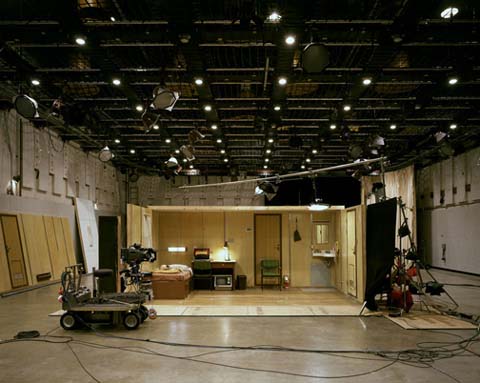Stan Douglas
dal 7/11/2001 al 22/12/2001
Segnalato da
7/11/2001
Stan Douglas
David Zwirner, New York
"Journey into Fear" title of his latest film. The work is based on two feature films by the same title: Norman Foster’s 1942 war-time thriller and its remake, shot in Vancouver in 1975, directed by Daniel Mann. Stan Douglas uses as location for his new film a generic cargo vessel, possibly the most utilitarian symbol of globalization. The related photographs exhibited in the gallery depict the Vancouver harbor, a container yard, containers, as well as production stills from the film set

Opening on November 8th, the gallery will present an exhibition of
new work by the Canadian artist Stan Douglas. On view will be
photographs as well as a DVD film installation. This will be the artist’s
fifth solo exhibition at David Zwirner.
Stan Douglas entitles his latest film "Journey into Fear". The work is
based on two feature films by the same title: Norman Foster’s 1942
war-time thriller and its remake, shot in Vancouver in 1975, directed
by Daniel Mann. Whereas war-and-weapon espionage drives the plot
in Foster’s original film, Daniel Mann opted to substitute industrial
espionage into the storyline of his remake, reflecting the changed
world separating the two filmings of "Journey into Fear".
The setting of the 1942 version is the Second World War and the
context of the 1975 remake is the 1973 oil crisis. These two events
are significant for Stan Douglas’ new project because the former
initiates and the latter roughly marks a halfway point in the transition
from internationalism to globalism; the passage from a world in which
power is brokered by politics to one in which finance is the dominant
medium of influence and exchange.
Stan Douglas uses as location for his new film a generic cargo
vessel, possibly the most utilitarian symbol of globalization. The
related photographs exhibited in the gallery depict the Vancouver
harbor, a container yard, containers, as well as production stills from
the film set: a passenger cabin on a container ship. A 16-foot large
panorama of a Vancouver street scene, a portrait of the
contemporary global market place, completes the gallery installation.
As is the case with all of his work, Stan Douglas locates "Journey in
Fear" into a particular historical moment. That the stage for the global
dominance of financial markets was abruptly set by the 1973 oil crisis
is proof that, far from being a dead zone between the emancipatory
utopias of the 1960s and the protectionist greed of the 1980s, the
current distribution of power is the secret "meaning" of the 1970s.
[Stan Douglas]
Stan Douglas’ version of "Journey into Fear" leaves the viewer
guessing whether it is set in the present or maybe in the 70’s. As in
earlier works, he does not offer a beginning or an end in this film but
rather, he invites the gallery viewer to enter the looped film at any
time: A man and a woman are arguing in the cramped cabin of a
container ship. The dialogue reveals their tension; something big is at
stake. He needs her confidence. He needs to persuade her. She
rejects. He offers bribes and threatens murder. But mostly, the two
just talk. Their conversation seems to go nowhere and more than that,
it appears to go on forever as the film loops between the exterior
scenes shot on the ship (are they flashbacks or flash-forwards?) and
the interior scenes.
Stan Douglas has created a fixed loop of scenes within the picture
track of his work. However, the dialogue accompanying these
scenes, changes (almost) endlessly as a computer picks at random
from different dialogue possibilities that are lip-synched through a
dubbing process. As the scenes and its actions repeat themselves,
the dialogue mutates continuously so that it would take days for the
exact same scene and dialogue to reappear.
Stan Douglas evokes the 70’s as a backdrop for an intense
psychological exchange. In his "Journey into Fear", protagonist and
antagonist continuously trade places as the claustrophobia of the
endless film and dialogue loop contracts until the film finally reveals
its true identity, that of a machine. Its repetitions and mutations create
a haunting metaphor for the perception of time in modernity. "Journey
into Fear" is an endless, cyclical voyage but, when compared with its
earlier iterations, one can at least intuit how the future became
history. [Stan Douglas]
For further information, please contact the gallery at 212.966-9074
Image: Journey into Fear: Pilot's Quarters 1 and 2 (detail) 2001 diptych: 2 C-prints 28 x 35 inches Edition of 7
David Zwirner
43 Greene St. (between Grand and Broome) New York, NY 10013
Telephone 212-966-9074 Fax 212-966-4952
Hours
The gallery is open to the public Tuesday through Saturday from 10 AM to 6 PM only during scheduled exhibitions.



